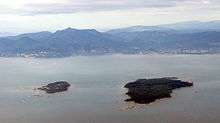Lérins Islands

The Lérins Islands (in French: les Îles de Lérins, pronounced: [lɛz‿il də leʁɛ̃]) are a group of four Mediterranean islands off the French Riviera, near Cannes. The two largest islands in this group are the Île Sainte-Marguerite and the Île Saint-Honorat. The smaller Îlot Saint-Ferréol and Îlot de la Tradelière are uninhabited. Administratively, the islands belong to the commune of Cannes.
The islands are first known to have been inhabited during Roman times.
The Île de Saint-Honorat bears the name of the founder of the monastery of Lérins, Saint Honoratus. It was founded around the year 410. It is in this monastery that Saint Porcarius lived and probably was killed during an invasion by Saracens. According to tradition, Saint Patrick, patron of Ireland, studied there in the fifth century.
A fortified monastery was built between the eleventh and fourteenth centuries. In 1047 the islands were raided by Muslim Andalusi pirates. The monastic community today lives in a monastery built during the nineteenth century.
The Île Sainte-Marguerite held a fortress where the Man in the Iron Mask was held captive for a time.
The battle of 1637 on Lérins Islands is one of the battles of the Thirty Years' War between the Spanish Catholic Monarchy and the Kingdom of France . This combined naval and land operations and mobilized 39 ships, 11 galleys, 6 fire ships, 12 flutes, and a large fleet of transport. The Spanish garrison was reduced and the French attacked with all their forces. On March 24, 1637 began the siege of the Lérins Islands and the beginning of the attack of five Spanish forts. After a siege of 45 days, the Spaniards from Sainte-Marguerite Island capitulate on 12 May and those of Saint- Honorat Island May 13 . Cardinal Sourdis celebrates a thanksgiving Mass with Te Deum May 14
In 1707 the Lérins were occupied by the English navy, under the command of Sir Cloudesley Shovell. This was done in order to block the military port of Toulon to help the army of Victor Amadeus II Duke of Savoy and his cousin Eugene besiege that city.
Under the French Revolution, the Île Sainte-Marguerite and the Île Saint-Honorat were renamed the Île Marat and the Île Lepeletier, after secular martyrs.
Ile St Marguerite
Ile St Marguerite (Saint Margaret Island) is about a 15-minute boat ride away from Cannes. The cell of the mysterious 'Man with the Iron Mask' can be visited in the Fort of St Marguerite, now renamed the Musée de la Mer (Museum of the Sea). This museum also houses archaeological discoveries from shipwrecks off the coast of the island, including Roman and Saracen ceramics. There is a regular boat service from the mainland. Guided tours in English are available in summer.
Ile St Honorat
Ile St Honorat (Saint Honorat Island), the smaller, southern island, is only inhabited by Cistercian monks. Monks have inhabited the island more or less continuously since AD410 and, at the height of their powers, owned Cannes, Mougins and Vallauris, plus Seborga, Italy. Medieval vestiges remain in the stark church, which is open to the public, and in the ruins of the 11th-century monastery on the sea’s edge. The monks divide their time between prayer and producing red and white wine, honey, lavender oil and Lérina, a herbal liqueur. Although closed to the general public, the monastery welcomes guests for week-long retreats. The monks also run the only boat trips to the island, with departures from Cannes jetty Edouard.
See also
External links
| Wikimedia Commons has media related to Îles de Lérins. |
Coordinates: 43°30′54″N 7°2′42″E / 43.51500°N 7.04500°E